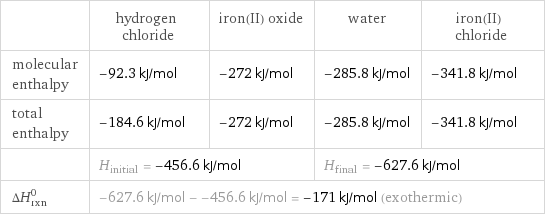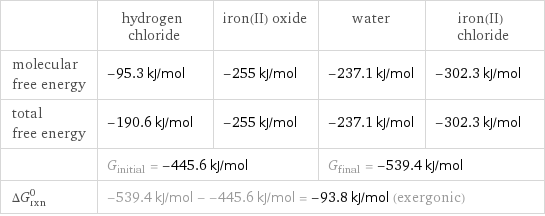Input interpretation

hydrogen chloride + iron(II) oxide ⟶ water + iron(II) chloride
Balanced equation

Balance the chemical equation algebraically: + ⟶ + Add stoichiometric coefficients, c_i, to the reactants and products: c_1 + c_2 ⟶ c_3 + c_4 Set the number of atoms in the reactants equal to the number of atoms in the products for Cl, H, Fe and O: Cl: | c_1 = 2 c_4 H: | c_1 = 2 c_3 Fe: | c_2 = c_4 O: | c_2 = c_3 Since the coefficients are relative quantities and underdetermined, choose a coefficient to set arbitrarily. To keep the coefficients small, the arbitrary value is ordinarily one. For instance, set c_2 = 1 and solve the system of equations for the remaining coefficients: c_1 = 2 c_2 = 1 c_3 = 1 c_4 = 1 Substitute the coefficients into the chemical reaction to obtain the balanced equation: Answer: | | 2 + ⟶ +
Structures

+ ⟶ +
Names

hydrogen chloride + iron(II) oxide ⟶ water + iron(II) chloride
Reaction thermodynamics
Enthalpy

| hydrogen chloride | iron(II) oxide | water | iron(II) chloride molecular enthalpy | -92.3 kJ/mol | -272 kJ/mol | -285.8 kJ/mol | -341.8 kJ/mol total enthalpy | -184.6 kJ/mol | -272 kJ/mol | -285.8 kJ/mol | -341.8 kJ/mol | H_initial = -456.6 kJ/mol | | H_final = -627.6 kJ/mol | ΔH_rxn^0 | -627.6 kJ/mol - -456.6 kJ/mol = -171 kJ/mol (exothermic) | | |
Gibbs free energy

| hydrogen chloride | iron(II) oxide | water | iron(II) chloride molecular free energy | -95.3 kJ/mol | -255 kJ/mol | -237.1 kJ/mol | -302.3 kJ/mol total free energy | -190.6 kJ/mol | -255 kJ/mol | -237.1 kJ/mol | -302.3 kJ/mol | G_initial = -445.6 kJ/mol | | G_final = -539.4 kJ/mol | ΔG_rxn^0 | -539.4 kJ/mol - -445.6 kJ/mol = -93.8 kJ/mol (exergonic) | | |
Chemical names and formulas

| hydrogen chloride | iron(II) oxide | water | iron(II) chloride Hill formula | ClH | FeO | H_2O | Cl_2Fe name | hydrogen chloride | iron(II) oxide | water | iron(II) chloride IUPAC name | hydrogen chloride | oxoiron | water | dichloroiron